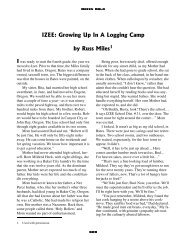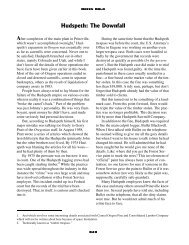Field Trip to the Trout Creek Japanese Crew Camp 2008
Field Trip to the Trout Creek Japanese Crew Camp 2008
Field Trip to the Trout Creek Japanese Crew Camp 2008
- TAGS
- trout
- creek
- senecakids.org
Create successful ePaper yourself
Turn your PDF publications into a flip-book with our unique Google optimized e-Paper software.
Seneca Students Explore His<strong>to</strong>rical <strong>Japanese</strong> <strong>Camp</strong><br />
Seneca School students in grades three through eight began this year’s<br />
work on <strong>the</strong> Seneca His<strong>to</strong>ry Project with a field trip <strong>to</strong> <strong>the</strong> south end of<br />
Silvies Valley <strong>to</strong> view <strong>the</strong> site of a fascinating piece of Hines Lumber Co.<br />
his<strong>to</strong>ry.<br />
The <strong>Trout</strong> <strong>Creek</strong> <strong>Camp</strong> was established by <strong>the</strong> Edward Hines Lumber<br />
Co. soon after <strong>the</strong> outbreak of WWII. In need of workers <strong>to</strong> fill <strong>the</strong> gaps left<br />
by men going <strong>to</strong> war and <strong>to</strong> meet <strong>the</strong> increased demand for lumber, company<br />
representatives approached <strong>Japanese</strong> citizens loyal <strong>to</strong> <strong>the</strong> United States who<br />
were incarcerated at <strong>the</strong> Tule Lake Segregation Center in California.<br />
Initially, five men were recruited.<br />
When <strong>the</strong>y arrived in Silvies Valley in 1943, <strong>the</strong>y found a bunkhouse<br />
and a kitchen <strong>the</strong>re for <strong>the</strong>ir use, and miles of poor railroad and fences <strong>to</strong><br />
maintain. Frank Eki built a small cabin so he could send for his family;<br />
o<strong>the</strong>rs followed suit. <strong>Trout</strong> <strong>Creek</strong> <strong>Camp</strong> grew, and was eventually home <strong>to</strong><br />
four families and several bachelors. The Eki family lived <strong>the</strong>re for over<br />
twenty years until <strong>the</strong> camp closed.<br />
Nothing much remains now except for <strong>the</strong> well and pump which<br />
supplied <strong>the</strong> water <strong>to</strong>wer, piles of timbers and boards, some lef<strong>to</strong>ver rails, a<br />
shed filled with track maintenance parts, and a small building on skids. The<br />
students were accompanied by Keith Schatz, who had been <strong>to</strong> <strong>the</strong> camp<br />
many times while it was still occupied, and learned from him how<br />
extensively <strong>the</strong> camp was laid out. The students collected several items of<br />
interest <strong>to</strong> add <strong>to</strong> <strong>the</strong>ir ever-growing school museum.<br />
On Oc<strong>to</strong>ber 23, students will continue <strong>the</strong>ir research at <strong>the</strong> Four<br />
Rivers Cultural Museum in Ontario, which has an exhibit on <strong>the</strong> experiences<br />
of relocates in <strong>Japanese</strong> Internment <strong>Camp</strong>s.<br />
Seneca School would like <strong>to</strong> thank Keith Baltzor of <strong>the</strong> Silvies Valley<br />
Ranch for guiding <strong>the</strong> students <strong>to</strong> <strong>the</strong> site. The entire s<strong>to</strong>ry of <strong>the</strong> <strong>Trout</strong><br />
<strong>Creek</strong> <strong>Camp</strong>, as <strong>to</strong>ld by Frank and Betty Eki, will be included in volume two<br />
of <strong>the</strong> Seneca School Oral His<strong>to</strong>ry Project, <strong>to</strong> be published later this year.<br />
More about <strong>the</strong> Seneca His<strong>to</strong>ry Project can be learned by visiting <strong>the</strong> Seneca<br />
School Foundation’s website at www.senecakids.org.







